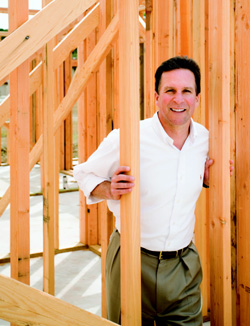BMHC also has made sure that the people running the firms it acquires have a reason to stay even after a deal is struck. For instance, when it first invested in Knipp Bros., in addition to allowing the framer to continue to operate essentially under its own direction day-to-day, BMHC initially bought just 49 percent of the company, with an option to buy the rest of the firm down the road. That kept Larry Knipp, and the local relationships he’d built in Phoenix, involved in the businesses for years. (Knipp has since retired.) BMHC has used similar structures in many of its subsequent acquisitions, something that’s viewed as a key to its success. “When they go into a new market, they’ve been really good at incentivizing the local people to stay on board,” Hughes says.
Test of Time Yet for everything SelectBuild has accomplished, many observers say its true challenge lies ahead, especially as housing markets begin to slow. “We know they’ve done absolutely fantastic in the good times. We need to see how they’ll hold the line in the mediocre times,” says Hughes. “I don’t think the real test of the BMHC model has played itself out yet.”
For instance, since pushing into services, BMHC has been able to grow revenue to $2.9 billion while nearly tripling its profit margin to 4.4 percent. But Hughes points out that the growth came “during the greatest run in housing that we may ever have.” Indeed, after its first-quarter conference call, when it reported a record year-over-year increase in net income for the eighth consecutive quarter, the company’s stock took a pounding on Wall Street, due to slightly lower margins overall, which the company attributed to the acquisition of less profitable trades such as plumbing and concrete, as well as softer markets.
But for the BMHC team and its newly minted SelectBuild division, how the company performs over the next 90 days, or whether pouring slabs produces less profit than erecting a frame, isn’t the point. Much more important is that vision of a horizon filled with SelectBuild-built homes, footed on the landscape of BMHC’s future and banked by its conviction that home builders will continue to demand more and more services. Now far removed from its first gutsy move of buying a “smoke-and-mirrors” framer, the company is ready to expand its reach in markets like Texas and Colorado, while identifying new trades, such as electrical, roofing, and drywall, to round out its construction offerings. (The firm recently tapped an additional $150 million in its revolving credit facility to bring its total war chest to $200 million, ensuring that it has adequate cash to buy at will, especially if slower markets cause further consolidation among the trades.)
“We will continue to expand our construction services in a very deliberate manner, looking at the construction process as a linear function, and try to invest where we see opportunities to create synergies on the jobsite,” says Mahre. “You’ll see us enter new, additional markets, as well.”
Chances are, when they do, they won’t come wearing ties. —Joe Bousquin is a contributing editor for PROSALES.
Vital Statistics
Company: BMHC
Year founded: 1987 Headquarters: San Francisco
Number of locations: 157
Number of employees: 21,000
2005 sales: $2.9 billion
Pro sales percentage: 100 percent
BMHC Construction Services Acquisitions Starting with Knipp Bros. in ‘99, BMHC has rounded up 16 construction services firms to lay the foundation for what is now SelectBuild. The anatomy of the construction services juggernaut is bound by its focus on buying the best skilled labor in the hottest markets.
SOURCE: BMHC

